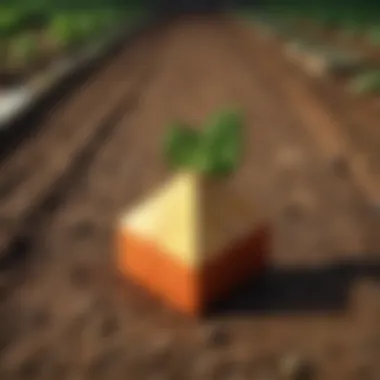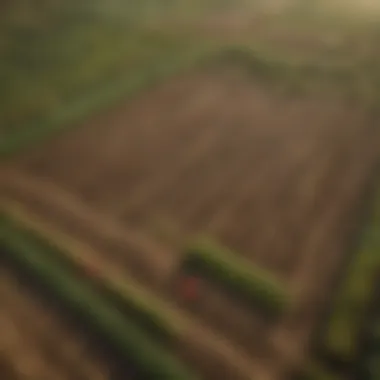Calculating Area in Agriculture: Methods and Applications


Intro
Calculating area is a fundamental aspect of various sectors, particularly agriculture. This involves not only understanding basic geometric principles but also applying these principles to practical situations. In agriculture, accurate area calculation is crucial for effective land management, crop planning, and resource distribution. With growing awareness of sustainability and efficiency, the methods and technologies used in these calculations have evolved significantly.
Farmers and agricultural enthusiasts stand to benefit immensely from mastering area calculation techniques. It aids in making informed decisions regarding crop choices, planting densities, and resource allocation. The integration of modern technology increases precision in measurement and promotes better management of agricultural land.
Current Trends in Agriculture and Horticulture
Overview of Recent Innovations
In recent years, agriculture has seen a wave of innovations that reshape traditional practices. Drones, for instance, are transforming the landscape of area measurement. They provide aerial views and accurate data, allowing farmers to assess their fields more effectively. Likewise, Geographic Information System (GIS) technology plays a pivotal role in mapping and analyzing land utilization.
Modern farming increasingly relies on precision agriculture, which integrates tools like soil sensors and satellite imagery. These innovations help farmers understand their land better, ensuring efficient use of resources and higher yields. Precision techniques enhance the accuracy of area calculations associated with applying fertilizers or treatments, optimizing productivity.
Sustainable Practices Gaining Popularity
Sustainability is now at the forefront of agricultural practices. This shift influences area calculation strategies as researchers emphasize techniques that promote ecological balance. Crop rotation, cover cropping, and reduced tillage are examples of methods that not only enhance soil health but require careful area management.
Practices like agroforestry combine crops with tree planting, improving biodiversity. This, in turn, requires precise area calculations to maximize benefits while minimizing land use. Such sustainable approaches gain traction among farmers looking to balance profitability with environmental stewardship.
Essential Farming Techniques
Soil Health Management
Soil health is integral to successful farming. Accurate area calculations help in assessing how much soil amendment is necessary for specific fields. Farmers can determine the amounts of organic matter or nutrients required based on calculated area. Utilizing soil tests enables targeted interventions, thereby improving the fertility of designated plots efficiently.
Pest and Disease Control Strategies
Controlling pests and diseases also relies on precise area understanding. By calculating the area of affected plots, farmers can implement control measures effectively. This might include the targeted application of pesticides or setting up barriers. Using data from precision agriculture allows for minimal intervention while maximizing results.
Tools and Technology in Farming
Overview of Advanced Farming Tools
Today’s farmers have access to a plethora of advanced tools that assist in area calculation and management. Global Positioning System (GPS) devices are now commonplace, helping in tracing field boundaries accurately. This allows farmers to gather data without the need for extensive manual measurements.
Additionally, advanced software solutions offer farmers user-friendly platforms to input data. These systems can calculate area and provide insights based on various parameters, aiding decision-making processes.
Case Studies on the Use of Technology
Several case studies highlight the effective use of technology in area calculations. For example, the integration of GIS in vineyards has led to improved yield predictions. By monitoring growth patterns through precise area calculations, vineyard owners can adjust practices appropriately, leading to enhanced quality of grapes.
The examples demonstrate that technology’s role in agriculture is indispensable. With the movement toward greater efficiency and sustainability, understanding these tools can empower farmers to optimize their practices.
The mastery of area calculation in agriculture is not merely academic; it is an essential skill that fosters sustainability, efficiency, and productivity in farming operations.
Understanding Area
Understanding the concept of area is indispensable, especially in fields like agriculture. It serves as a foundation for various practices essential to effective farming. Knowledge of area allows farmers to make informed decisions regarding land use, resource allocation, and crop management.
Farmers must grasp the principles of calculating area accurately. This knowledge leads to optimized cultivation and efficient use of available resources. Throughout this section, we will explore its definition, historical development, and its critical role in agricultural practices.
Definition of Area
Area is a measurement of the extent of a two-dimensional surface. It is usually expressed in square units like square meters, hectares, or acres. The calculation of area provides a numerical value that indicates how much space an object occupies.
In agriculture, knowing the area of fields or plots is crucial. For instance, it helps in determining how many seeds can be planted in a given space. Understanding area paves the way for effective planning and management. It is not just a mathematical concept; it has real-world implications that can significantly impact yield and sustainability.
Historical Context
Historically, the measurement of area dates back to ancient civilizations. Egyptians used simple geometry to gauge land after floods. The Greeks and Romans advanced these principles further by developing more sophisticated formulas we still utilize today.
In the context of agriculture, area measurement has evolved alongside food production techniques. The introduction of land surveying in the Middle Ages allowed for more accurate delineations of farming lands. Over time, this knowledge has become increasingly vital with the expansion of agricultural practices.
Importance of Area in Agriculture


The significance of area is multi-faceted in agriculture.
- Land Management: Accurate area calculations assist farmers in managing their land effectively. By knowing the area, they can allocate resources better, improving sustainability and minimizing waste.
- Crop Planning: Determining the area enables farmers to plan crop rotations and types effectively. It assists in maximizing yield based on land capacity.
- Resource Allocation: Being aware of the area informs decisions on water usage, fertilizer application, and labor management.
In summary, understanding area is not merely academic. It directly influences farming efficiency and resource use. Farmers equipped with this knowledge are better positioned to enhance their productivity and environmental stewardship.
Geometric Shapes and Area Formulas
Understanding geometric shapes and their area formulas is crucial in agriculture. These measurements help farmers optimize land usage, enhance crop yields, and effectively allocate resources. By knowing how to calculate areas accurately, one can make informed decisions that lead to better land management and productivity.
Calculating Area of Regular Shapes
Squares and Rectangles
Squares and rectangles are foundational shapes in area calculation. They represent some of the simplest geometric forms, making them easy to understand and apply in practical situations. Their key characteristic is that the opposite sides are equal, allowing for straightforward computations using the formula: Area = Length x Width. This clarity makes squares and rectangles a popular choice in agricultural layouts, such as fields and growing plots.
The unique feature of these shapes is their uniformity. Square and rectangular fields allow for systematic planting and harvesting procedures. Their advantages include simplicity in measuring and optimizing space. However, the disadvantage lies in their limited adaptability to irregular terrains, which is common in agriculture.
Triangles
Triangles present an interesting aspect of area calculation. The formula to calculate the area of a triangle is: Area = 1/2 x Base x Height. Highlighting their versatility, triangles can fit into various layouts and landscapes more easily than rectangular shapes. They can help farmers utilize land that might be difficult to measure with traditional shapes.
The key characteristic of triangles is their ability to handle slopes and variations in terrain. They are thus a beneficial option for farmers working on hilly or uneven land. Moreover, the use of triangular plots can enhance drainage, leading to better crop health. The disadvantage is the complexity in calculating area accurately if the base or height is not easily accessible.
Circles
Circles, with their unique geometric nature, offer another approach to area calculation in agriculture. The area of a circle is calculated using the formula: Area = π x Radius². Key characteristic of circles is their symmetry and uniformity, which can help in designing circular plots or irrigation systems.
Circle shapes can be beneficial in situations requiring equal distribution of resources, such as water or sunlight. They also reduce wasted space in certain layouts. However, the disadvantages are notable. Circular fields can be less efficient for planting straight rows of crops, making use of modern machinery a challenge.
Calculating Area of Irregular Shapes
Irregular shapes are prevalent in agriculture and present a more complex challenge for area calculation. Utilizing various methods can achieve accurate measurements across a variety of terrains and field patterns.
Composite Figures
Composite figures consist of multiple geometric shapes combined to form a larger, more complex shape. They are quite common in agricultural settings where fields may not follow a distinct geometric pattern. The challenge of calculating the area lies in breaking down the composite shape into manageable sections, each of which can be handled using established formulas for regular shapes.
Such figures are beneficial because they reflect true land use conditions, allowing for optimal planning and harvest strategies. However, the disadvantages include increased time and effort required to calculate areas accurately, especially when relying on manual methods.
Use of Approximation Techniques
Approximating the area of irregular shapes uses various methods, such as grid techniques, to estimate land area. This is particularly useful for large fields or areas with undefined boundaries. Estimation techniques often involve overlaying a grid on a map to count the number of grid squares that cover the area in question.
The key characteristic of these approximation techniques is their speed and efficiency, which can save valuable time for farmers who need quick decisions about land use. They represent a beneficial approach for preliminary assessments. However, the downside is that these methods can lead to less accuracy, especially in precision agriculture where exact measurements are critical for effective planting and resource management.
In agriculture, knowing the exact area of land can significantly impact crop yield and resource allocation.
Measurement Units in Area Calculations
Understanding measurement units is crucial in area calculations, especially in agriculture. Accurate area measurement informs many critical decisions, from planting crops to managing land resources. The choice of units can significantly affect outcomes. Farmers, land planners, and agricultural technicians must navigate these measurement standards to optimize their operations and investments.
Area measurement is often expressed in square units, such as square meters, acres, or hectares. The unit's selection may rely on the region's common measurements or the specific agricultural needs of a project.
Using appropriate units of measurement ensures consistency and precision. For example, when estimating the space required for planting crops, a farmer using the metric system may find it easier to do calculations in square meters. In contrast, a farmer in the United States may prefer acres. Standardization in measurement helps streamline processes in large agricultural operations. Understanding and converting between systems is essential for effective land management practices.
Metric vs Imperial Systems
The metric system, utilized widely across many countries, reflects a decimal-based approach. It simplifies calculations due to its straightforward conversions. Common metric units for area include square meters (m²) and hectares. A hectare equals 10,000 square meters. In agriculture, this system proves advantageous for records, documentation, and interfacing with international standards.
On the other hand, the imperial system is prominent primarily in the United States. It uses units like square feet, square yards, and acres. An acre represents 43,560 square feet or 4,840 square yards. While traditional in the U.S., the imperial system can complicate conversions and measurements, especially in large-scale farming.
Benefits of Each System
- Metric System:
- Imperial System:
- Easier for mathematical conversions.
- Internationally recognized, promoting a universal approach.


- Familiarity for many farmers in the U.S.
- Tradition rooted in local practices.
Deciding on which system to use depends on the local context and the scope of agricultural practices. Understanding both systems allows for more effective communication with suppliers, clients, and partners.
Converting Between Measurements
Efficient area calculation sometimes necessitates converting between metric and imperial measurements. Familiarity with these conversions allows farmers to interpret data correctly, whether from international reports or local recommendations. Here are some essential conversions that can prove useful:
- 1 hectare is approximately equal to 2.47 acres.
- 1 acre is approximately equal to 0.4047 hectares.
- 1 square meter is approximately equal to 10.764 square feet.
- 1 square foot is approximately equal to 0.0929 square meters.
Accurate conversions prevent misunderstandings that could lead to inadequate land management or inefficient planting strategies. Farmers might utilize conversion calculators or charts to assist in these tasks.
Moreover, software applications can facilitate quick conversions, promoting efficiency in decision-making. Ensuring that all calculations adhere to the selected measurement units is vital for maintaining precision in agricultural operations.
Technological Advances in Area Measurement
In modern agriculture, accurate area measurement is crucial. The advances in technology have redefined how land is measured. Tools such as GPS and drones are transforming traditional practices, enhancing precision and efficiency. These technologies allow farmers to collect data with greater accuracy, leading to better decision making. By integrating advanced methods, agricultural organizations can optimize yield and management techniques, ensuring sustainability and profitability.
Technological innovations also reduce the risk of human error in measurements. When farmers rely on manual methods, inaccuracies can arise. However, implementing these new technologies minimizes mistakes and provides reliable data. With precise measurements, resource allocation becomes more effective, ultimately leading to improved productivity.
GPS and Mapping Technologies
Global Positioning System (GPS) is one of the cornerstones in the evolution of area measurement. GPS technology provides precise location data, allowing farmers to map their fields accurately. The use of GPS makes it easier to establish property boundaries and identify different crop zones. This data is essential for planning effective land management strategies.
- Benefits of GPS in Area Measurement:
- Enhances accuracy in field mapping.
- Facilitates efficient use of resources.
- Supports crop monitoring and management.
- Provides data needed for regulatory compliance.
The accuracy achieved through GPS technology can lead to optimized planting, irrigation, and harvesting. Farmers can make informed decisions by knowing the exact size and shape of their fields.
Drones and Remote Sensing
Drones have emerged as powerful tools in agricultural area measurement. These unmanned aerial vehicles enable farmers to gather aerial imagery and data over large areas. Remote sensing technologies collect detailed information about crop health, soil characteristics, and field conditions.
The integration of drones into agricultural practices provides numerous advantages:
- High-resolution images assist in accurate mapping of fields.
- Multispectral sensors can identify different vegetation types and health status.
- Time efficiency, as drones can survey large areas quickly compared to traditional methods.
Utilizing drones makes it possible to monitor changes in soil and crop conditions over time, allowing for timely interventions.
"The future of agriculture relies heavily on technological advancements in area measurement, making practices more efficient and sustainable."
In summary, technological advancements in area measurement have transformed how agriculture is practiced. Tools like GPS and drones offer precise data, enhancing resource management and operational efficiency. Farmers can now adapt to changing agricultural landscapes with confidence.
Applications of Area Calculation in Agriculture
Understanding the practical applications of area calculation in agriculture is essential. Accurate area measurements enhance various agricultural activities, leading to improved productivity and sustainability. Farmers and agricultural managers can utilize area calculations for effective land management, strategic crop planning, and efficient resource allocation.
When farmers calculate the area, they can determine how much land is available for cultivation. This information is vital for making decisions regarding crop selection, crop rotation, and maximizing yield. By knowing the area precisely, farmers can optimize their cultivation practices, leading to better outcomes.
Land Management Practices
Land management is a crucial aspect of agriculture. Calculating the area accurately allows for better organization and use of land. It enables farmers to identify which parts of the land are suitable for different crops and how to manage them effectively.
- Soil Health Assessment: Understanding the area helps in evaluating soil quality across different plots. Farmers can decide where to apply fertilizers or implement cover crops.
- Sustainable Practices: Precision in area calculations aids farmers in adopting sustainable practices, like rotation and intercropping, which can improve soil fertility and reduce pest issues.
A well-defined management plan, based on accurate area data, ensures that resources are used efficiently, helping to increase both crop yield and quality.
Crop Planning and Rotation
Successful crop planning relies heavily on accurate area calculations. Knowing the exact area of each field allows farmers to select appropriate crops based on market demand, soil type, and climate conditions.
- Diversity in Cropping: Farmers can plan for a diverse range of crops, minimizing risks associated with monoculture. By rotating crops, they can maintain soil health and improve resilience against pests.
- Timing and Scheduling: Proper area measurement allows for better scheduling of planting and harvesting. This ensures that crops grow in their optimal environments and can be harvested at the right time for maximum benefit.
Incorporating area calculations in crop planning leads to better allocation of time and resources, resulting in higher efficiency.
Resource Allocation Strategies


Effective resource allocation is key to successful farming. Accurate area measurements inform farmers about how much water, fertilizer, and labor are needed on specific plots. This improves productivity and reduces waste.
- Water Management: With precise area data, farmers can implement efficient irrigation systems. This ensures that each crop receives the right amount of water based on its needs.
- Cost Management: Understanding the area allows for budget planning. Farmers can allocate funds smartly by prioritizing inputs based on the area of land being cultivated.
Ultimately, effective area calculations contribute to innovative farming practices, supporting farmers to enhance productivity and sustainability in their operations.
Accurate area measurement is crucial for modern agriculture, influencing decisions from land use to resource management.
In summary, applying area calculations in agriculture is not merely a mathematical exercise. It is a fundamental practice that drives many aspects of farming, ensuring that land and resources are used wisely for optimal productivity.
Best Practices for Accurate Area Calculation
Accurate area calculation is crucial in agriculture for various reasons. Precision in measuring the land affects decision-making related to crop planning, resource allocation, and land management. There are best practices that can enhance the accuracy of area measurements, ensuring that farmers can achieve optimal results in their agricultural endeavors.
Selecting Appropriate Methods
Choosing the right method for area calculation is foundational. There are different techniques available, and their suitability depends on factors such as the type of land and the purpose of the measurement. Methods like geometric calculations work best for regular shapes, while more complex areas require approaches like composite figures or approximation techniques. Farmers should consider:
- The shape of the land
- The available tools and technologies
- Purpose for which the measurement is needed
For larger areas, using modern technologies such as GPS and drones can improve accuracy. Tools like GIS (Geographic Information System) can also help in visualizing land and understanding its dimensions better. It is advisable to cross-verify measurements through alternative methods to reduce errors.
Training and Skills Development
Having trained personnel in area measurement is a significant asset. Improvement in skills and knowledge ensures that the team can utilize available tools effectively. Training should focus on the following aspects:
- Understanding measurement units and conversion techniques
- Familiarity with different area calculation methods
- Usage of technological tools like GPS and remote sensing
Workshops and online resources can provide valuable insights into precise area measurements. Keeping updated with the latest advancements ensures that farmers are equipped with current knowledge and skills.
"Accurate area calculation can lead to better resource management and increased productivity in agriculture."
Regular training sessions should be scheduled to refresh knowledge and accommodate new technologies. Furthermore, having a clear protocol for area measurement helps standardize practices across staff, leading to more reliable results.
Challenges in Area Measurement
Understanding the challenges involved in area measurement is crucial for the successful implementation of agricultural practices. Accurate area calculations directly impact land management, crop planning, and resource allocation. Several factors can adversely affect measurement precision, which in turn influences overall productivity and efficiency in agriculture. Addressing these challenges is necessary to enhance the effectiveness of agricultural strategies.
Environmental Factors
Environmental conditions play a significant role in area measurement. Variability in topography, vegetation cover, and weather can alter measurement results. For instance, uneven terrain complicates measurements since traditional measuring tools might not account for variations caused by hills or valleys. Similarly, dense vegetation can obscure the visibility of the land boundaries, leading to inaccurate readings.
Moreover, seasonal changes also influence area calculations. During rainy seasons, land can become more difficult to access, which potentially limits accurate survey capabilities. Factors such as soil moisture can distort perception of land boundaries, especially when fields are muddy.
To improve measurement under these conditions, employing advanced tools is essential. Technologies such as GPS and aerial imagery can mitigate these challenges by providing a clearer picture and more reliable reading of targeted areas.
Human Error in Measurement
Human error remains a persistent concern in area measurement. Despite possible advancements in technology, factors such as inaccurate tool usage, misread instruments, or improper data recording can lead to significant discrepancies. Incorrect calculations may arise from simple mistakes, such as misplacing decimal points or failing to account for all dimensions when calculating area.
Training personnel on proper measurement techniques is necessary. Even minor errors can lead to large implications in agricultural planning and resource distribution. Ensuring that measurements are taken during optimal conditions, while utilizing individual accountability and double-checking methods, can help in minimizing human fallacies.
"Accurate area measurements are fundamental to effective agricultural strategies. Mistakes in calculation can lead to wasted resources and decreased yields."
Future Directions in Area Calculation
As agriculture continues to evolve, the way we calculate area must also adapt to new technologies and methodologies. Future directions in area calculation hold great significance not only for improving precision but also for enhancing productivity in farming practices. Understanding these future trends is crucial for professionals in the agricultural sector who strive for efficiency and sustainability.
Emerging Technologies
New technologies are reshaping the landscape of area measurement. These innovations aim to improve accuracy and reduce the time needed for data collection. For example, Global Positioning System (GPS) technology is becoming increasingly sophisticated. It provides farmers with precise coordinates, enabling them to measure the area of their land with great confidence.
Drones have also become essential tools in agriculture. They can capture aerial images, allowing farmers to analyze their crops and land use patterns. This level of detail helps in making informed decisions based on actual field conditions. Furthermore, LiDAR (Light Detection and Ranging) technology can produce accurate topographical maps. Such tools not only help in measuring area but also in understanding the terrain's elevation and slope.
Moreover, the advancements in sensor technology are notable. Sensors can now collect real-time data on various factors, such as soil health and moisture levels. This information can be crucial when calculating optimal growing areas, as it directly influences crop yield.
Integration of Data Analytics
Integrating data analytics into area calculations can lead to significant improvements in agricultural practices. When large datasets are collected from various sources, they can provide insights that enhance decision-making processes. Farmers can analyze historical data alongside current metrics to identify trends and make predictions about crop performance.
Tools like Geographic Information Systems (GIS) are pivotal in this process. GIS allows farmers to visualize complex data sets on maps, making it easier to assess land use and identify underperforming areas.
By employing predictive analytics, farmers can optimize their operations. For instance, by analyzing data on weather patterns, soil conditions, and crop performance, they can tailor their planting strategies to specific areas of their land. This targeted approach not only boosts efficiency but also ensures sustainable practices by preventing overuse of resources.



